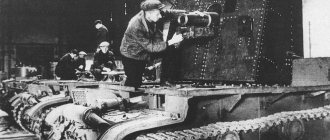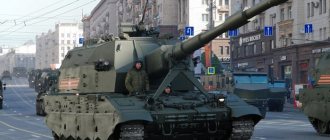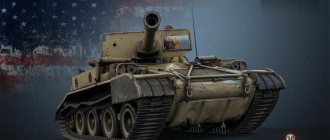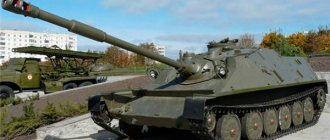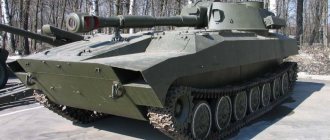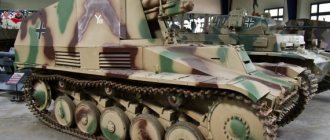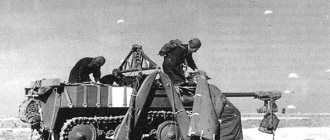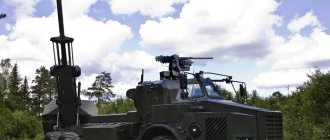Experimental self-propelled guns – AT-1
AT-1 (Artillery Tank-1) - according to the classification of tanks in the mid-1930s, it belonged to the class of specially created tanks; according to the modern classification, it would be considered an anti-tank self-propelled artillery mount manufactured in 1935. Work on the creation of an artillery support tank based on the T-26, which received the official designation AT-1, began at plant No. 185 named after. Kirov in 1934. It was assumed that the created tank would replace the T-26-4, the serial production of which the Soviet industry was never able to establish. The main weapon of the AT-1 was the 76.2 mm PS-3 cannon, designed by P. Syachentov. This artillery system was designed as a special tank gun, which was equipped with panoramic and telescopic sights and a foot trigger. The power of the PS-3 gun was superior to the 76.2-mm gun mod. 1927, which was installed on T-26-4 tanks. All work on the design of the new AT-1 tank was carried out under the leadership of P. Syachentov, who was the head of the design department for self-propelled guns at pilot plant No. 185 named after. Kirov. By the spring of 1935, 2 prototypes of this machine were produced.
Design Features
The AT-1 self-propelled gun belonged to the class of closed self-propelled units. The fighting compartment was located in the middle part of the vehicle in a protected armored room. The main armament of the self-propelled gun was the 76.2 mm PS-3 cannon, which was mounted on a rotating swivel on a pin stand. Additional armament was a 7.62 mm DT machine gun, which was mounted in a ball mount to the right of the gun. Additionally, the AT-1 could be armed with a second DT machine gun, which could be used by the crew for self-defense. To install it, there were special embrasures in the stern and sides of the armored cabin, covered with armored flaps. The crew of the self-propelled gun consisted of 3 people: a driver, who was located in the control compartment on the right in the direction of movement of the vehicle, an observer (aka loader), who was located in the fighting compartment to the right of the gun, and an artilleryman, who was located to the left of him. There were hatches in the roof of the cabin for boarding and disembarking the self-propelled gun crew.
The PS-3 cannon could send an armor-piercing projectile at a speed of 520 m/s, had panoramic and telescopic sights, a foot trigger, and could be used both for direct fire and from closed positions. Vertical guidance angles ranged from -5 to +45 degrees, horizontal guidance - 40 degrees (in both directions) without rotating the self-propelled gun hull. The ammunition included 40 cannon rounds and 1,827 machine gun rounds (29 discs).
The armor protection of the self-propelled gun was bulletproof and included rolled armor plates with a thickness of 6, 8 and 15 mm. The armored shell was made from sheets 6 and 15 mm thick. The connection of the armored parts of the hull was ensured by rivets. The side and rear armor plates of the wheelhouse were made hinged to allow removal of powder gases when firing at half their height. In this case, the gap is 0.3 mm. between the folding flaps and the body of the self-propelled gun did not provide the crew of the vehicle with protection from being hit by lead spray from bullets.
The chassis, transmission and engine were borrowed unchanged from the T-26 tank. The engine was started using an electric starter “MACH-4539” with a power of 2.6 hp. (1.9 kW), or "Scintilla" with a power of 2 hp. (1.47 kW), or using the crank. The ignition systems used a main magneto of the Scintilla, Bosch or ATE VEO type, as well as a starting magneto Scintilla or ATE PSE. The capacity of the fuel tanks of the AT-1 installation was 182 liters, this fuel supply was enough to cover 140 km. when driving on the highway.
The electrical equipment of the AT-1 self-propelled guns was manufactured using a single-wire circuit. The internal network voltage was 12 V. Scintilla or GA-4545 generators with a power of 190 W and a voltage of 12.5 V and a 6STA-144 battery with a capacity of 144 Ah were used as sources of electricity.
The fate of the project
The first copy of the AT-1 self-propelled gun was handed over for testing in April 1935. In terms of its driving characteristics, it was no different from the serial T-26 tank. Fire tests have shown that the rate of fire of the gun without aiming correction reaches 12-15 rounds per minute with a maximum firing range of 10.5 km, instead of the required 8 km. In contrast to the previously tested SU-1 installation, firing while moving was generally successful. At the same time, shortcomings of the vehicle were also identified, which did not allow the AT-1 to be transferred for military testing. Regarding the PS-3 gun, military engineer 3rd rank Sorkin wrote the following in his letter to the People's Commissar of Defense:
“Barrel No. 23 was mounted on the AT-1 and went through a full cycle of field tests with it... Guns No. 4 and 59 were tested many times at NIAP and gave satisfactory results, but completely uninterrupted operation of the automation was not achieved. Until this defect was eliminated, it was not possible to transfer the AT-1 system for military testing...”
Based on the results of tests of the AT-1 self-propelled gun, satisfactory operation of the gun was noted, but due to a number of parameters (for example, the inconvenient position of the rotating mechanism, the location of the ammunition, etc.) the self-propelled gun was not allowed for military testing.
The second copy of the AT-1 self-propelled gun was plagued by the same failures as the first. First of all, they were related to the work of the artillery installation. In order to “save” their project, specialists from the Kirov Plant came up with a proposal to install their own L-7 gun on the self-propelled guns. Unlike the PS-3 cannon, this gun was not created from scratch; its prototype was the 76.2 mm Tarnavsky-Lender system gun, thanks to which the L-7 gun had similar ballistics.
Although the designers stated that this gun was superior to all existing tank guns, in reality the L-7 also had a fairly large number of shortcomings. An attempt to equip the AT-1 with this weapon did not lead to success due to a number of design features, and it was considered inappropriate to design a new armored tank. Having compared all the available data on the ABTU project, it was decided to produce a small pre-production batch of 10 AT-1 self-propelled guns, which were equipped with PS-3 guns, as well as an improved chassis. They wanted to use this batch for extended range and military tests.
The production of PS-3 guns was planned to be established at the Kirov plant, self-propelled gun hulls were to be produced at the Izhora plant, and plant No. 174 was to supply the chassis. At the same time, instead of preparing the vehicle for serial production and eliminating the identified shortcomings of the PS-3 artillery system, the Kirovites were intensively promoting their designs. After the failure with the L-7 gun, the factory offered to try its improved version, which received the designation L-10. However, it was not possible to install this weapon in the AT-1 wheelhouse. The situation was aggravated by the fact that plant No. 174 was busy producing serial T-26 tanks, so even producing 10 chassis for the AT-1 self-propelled guns became an impossible task for it.
In 1937, the leading designer of self-propelled units of plant No. 185, P. Syachentov, was declared an “enemy of the people” and repressed. This circumstance caused the cessation of work on many projects that he supervised. Among these projects was the AT-1 self-propelled gun, although by that time the Izhora plant had already managed to produce 8 armored hulls, and plant No. 174 began assembling the first vehicles.
One of the AT-1 hulls produced was used only 3 years later, during the Soviet-Finnish war. In January 1940, at the request of the commanders and soldiers of the 35th Tank Brigade, which was fighting on the Karelian Isthmus, Plant No. 174 began work on creating a “sanitary tank”, which was intended to evacuate the wounded from the battlefield. This initiative was approved by the head of the ABTU of the Red Army D. Pavlov. As a basis for creating the vehicle, one of the AT-1 hulls available at the plant was used, which was converted on the spot, without any drawings, for the evacuation of the wounded. The factory workers planned to give a sanitary tank to tank crews for the holiday on February 23, but due to delays in production, the vehicle never made it to the front. After the end of hostilities, the T-26 ambulance tank (as it was called in factory documents) was sent to the Volga Military District; nothing is known about the further fate of this development.
To summarize, we can say that the AT-1 was the first self-propelled artillery unit in the USSR. For that time when the military was still keen on machine-gun wedges or tanks armed with 37-mm cannons, the AT-1 self-propelled gun could rightly be considered a very powerful weapon.
Performance characteristics: AT-1
Weight: 9.6 tons. Dimensions: Length 4.62 m, width 2.45 m, height 2.03 m. Crew: 3 people. Reservation: from 6 to 15 mm. Armament: 76.2 mm PS-3 cannon, 7.62 mm DT machine gun Ammunition: 40 rounds, 1827 machine gun rounds Engine: in-line 4-cylinder air-cooled carburetor from a T-26 tank with a power of 90 hp. Maximum speed: on the highway – 30 km/h, on rough terrain – 15 km/h. Cruising range: on the highway – 140 km, over rough terrain – 110 km.
Modules:
Turrets/guns
| Lv. | Tower | Armor (mm) | Rotation (deg/sec) | Review (m) | Weight, kg) | Price (credits) |
| II | AT-1 | 0/0/0 | 44 | 250 | 10 | 100 |
Compatible weapons:
| Lv. | gun | Penetration (mm) | Damage (HP) | Rapid fire (rounds/min) | Spread (m/100m) | Mixing (c) | BC | Weight, kg) | Price (credits) |
| II | 45 mm 20KS | 51/84/23 | 47/47/62 | 28.57 | 0.43 | 1.7 | 80 | 250 | 2 710 |
| III | 76 mm L-10S | 66/75/38 | 110/110/164 | 12.5 | 0.55 | 2.9 | 40 | 641 | 10 310 |
| IV | 57 mm ZiS-8S | 75/112/29 | 75/75/95 | 19.35 | 0.43 | 2.3 | 60 | 400 | 22 910 |
Engines
| Lv. | Engine | Power (hp) | Fire probability (%) | Weight, kg) | Price (credits) |
| I | T-26 | 90 | 20 | 545 | 770 |
| II | T-26F | 130 | 20 | 545 | 1 500 |
Chassis
| Lv. | Chassis | Max. load (t) | Turning speed (gr/sec) | Rmin | Weight, kg) | Price (credits) |
| II | AT-1 | 10.17 | 30 | 0 | 1 550 | 560 |
| III | AT-1 Bis | 10.8 | 32 | 0 | 1 550 | 1 790 |
Radio stations
| Lv. | Radio station | Communication range (m) | Weight, kg) | Price (credits) |
| III | 71-TK-3 | 300 | 100 | 570 |
Crew:
- Crew commander (Radio operator, Loader);
- Gunner;
- Driver mechanic.
Learning additional skills for the crew:
Standard crew Universal:
| 1 | 2 | 3 | 4 |
For the first slot, we teach all crew members, except the commander, the “ Repair” , and for the commander the “ Sixth Sense” skill - the “Repair” skill speeds up the repair of damaged modules, and the “Sixth Sense” will allow you to determine whether his tank has been detected by the enemy. Also, all crew members need to learn the additional skill “ Combat Brotherhood” , which will improve the level of proficiency in the specialty - be sure to learn it all at once, preferably used in the second or third slot.
- the Eagle Eye skill , which increases the viewing range.
- For the gunner we learn the skill “ Smooth turret rotation” , which reduces the spread when turning the turret; and the Sniper , which increases the chances of causing damage to modules and crew members.
- For the driver mechanic, we learn the “ Smooth Move” , which reduces the dispersion of the gun in motion; and the Off-Road King , which reduces drag on soft to medium ground when driving.
Ambush Sniper Crew:
| 1 | 2 | 3 | 4 |
For the first slot, we teach all crew members the “ Camouflage” , and for the commander the “ Sixth Sense” skill - the “Camouflage” skill will reduce the overall visibility of the tank, and the “Sixth Sense” will allow you to determine whether his tank is detected by the enemy. Also, all crew members need to learn an additional skill “ Combat Brotherhood” , which improves the level of proficiency in the specialty, must be studied by everyone at once, preferably used in the second or third slot.
- the Eagle Eye skill , which increases the viewing range.
- For the gunner we learn the skill “ Smooth turret rotation” , which reduces the spread when turning the turret; and the Sniper , which increases the chances of causing damage to modules and crew members.
- For the driver mechanic, we learn the “ Smooth Move” , which reduces the dispersion of the gun in motion; and the Off-Road King , which reduces drag on soft to medium ground when driving.
History of changes:
Update 0.6.7
- The rotation speed of the stock chassis is reduced by 2 degrees/sec.
- The influence of movement on spread for stock chassis has been increased by 5%.
- The cross-country ability of the top chassis has been reduced by 5%.
- Top chassis traverse speed reduced by 4 degrees/sec.
- The impact of movement on spread for top chassis has been increased by 5%.
- The aiming time of the 76mm L-10-S gun is set to 2 seconds.
- The aiming time of the 57mm ZIS-8-S gun is set to 1.5 seconds.
Update 0.7.0
- Transfer to a new booking system (16 groups + screens).
- 4483 -> 4400 .
Update 0.7.5
- The turning speed of the first chassis has been reduced by 3 degrees/sec.
- The turning speed of the second chassis has been reduced by 3 degrees/sec.
- Reverse speed increased by 1 km/h.
Update 0.8.0
- The spread of the gun due to the movement and rotation of the AT-1 chassis has been reduced by 6%.
- The dispersion of the gun due to the movement of the AT-1 bis chassis has been reduced by 6%.
- The dispersion of the 37 mm ZiS-19S gun when rotating the barrel has been reduced by 20%.
- The dispersion of the 45 mm 20KS gun when rotating the barrel has been reduced by 20%.
Update 0.8.6
- Profitability increased by 10%.
Update 0.9.15.1
- The tank has been redesigned with a new visual quality.
Combat effectiveness
AT-1 has the following advantages:
- good selection of guns with high rate of fire, accuracy, penetration and damage.
- low visibility, even when shooting
- excellent mobility and maneuverability
- good horizontal aiming angle
Flaws:
- small review
- weak armor
- small margin of safety
It’s not for nothing that the AT-1 is called the “King” of the sandbox; it can handle almost all the tanks it can get into battle with (exceptions: AMX40 and B1), so its main advantage is its gun. Using ambush tactics, we level out our shortcomings: armor - with the help of camouflage, visibility - with the help of a stereo scope.
Order of studying modules:
| Chassis | gun | Engine | gun | |
| Result: Experience: 1,410 Credits: 36,510 | ||||
| AT-1 Bis | 57 mm ZiS-8S | T-26F | 76 mm L-10S | |
| 330 experience - 1790 credits | 550 experience - 22910 credits | 130 experience - 1500 credits | 400 experience - 10310 credits |
More details on the research.
- AT-1 Bis chassis - will add carrying capacity and also increase the maneuverability of the tank.
- The 57 mm ZiS-8S gun has high penetration and high damage per minute.
- The T-26F engine significantly increases dynamics.
- The 76 mm L-10S gun has high one-time damage and is required to obtain the “Elite” status.
